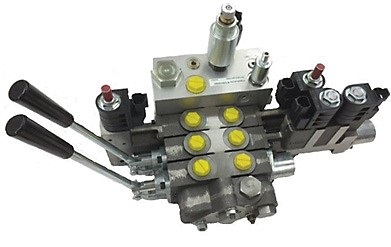By Scott Knaack, Sr. VP of Sales and Marketing
Prince Hydraulics
Hydraulic directional control valves have always been fundamental to hydraulic circuits, machinery and equipment, but an increase in technology is bringing a new level of performance, sophistication and efficiency to these crucial workhorses. Today we see things such as fine metering spools, load sense, proportional features and remote controls to shift spools. All of these features can provide more control, more efficient use of the valve and energy savings. These features, in turn, help lower operating costs.

Directional valves have been used for many years. They can range from being simple, low-cost and compact to ultra-sophisticated, multi-section instruments with price tags to match. Whether you need a single-spool valve to operate a log splitter or a stack valve with 8, 10 or even more work sections, you will be able to find, or configure, a valve with the options that allow it to work in the application needed.
Critical design considerations
No matter how complex a valve might become, it is important to keep in mind a few basic ideas. A valve essentially consists of a spool inside a casting that is either controlled mechanically or electrically. Directional valves come in two main categories: either a sectional valve (sometimes called a stack valve) or a mono block design. Sectional valves offer far more flexibility, options and complexity, while mono block vales are usually more economical as well as smaller in physical size.
Be sure to research the following considerations before choosing or designing a directional valve:
• Is it a parallel or tandem circuit?
• Do you need an open- or closed-center for oil flow?
• What is the number of gallons per
minute from the source?
• How many directions do you want the oil to flow (this is referred to as spool type and is usually expressed as three- way, four-way)?
• How many handle (spool) positions do you want (usually three-position or
four-position)?
• What is the spool action, such as spring center to neutral or various detent selections?
• And finally, do you need the valve to be manually or electronically controlled or both?
The most common circuit is the parallel circuit. In this design, when any one of the spools is shifted, it blocks off the open center passage. Oil then flows into the parallel circuit core, making oil available to all spools. If more than one spool is shifted, the oil will flow to the path of least resistance. When a spool is shifted in tandem, also referred to as a priority circuit, oil is cut off to all downstream sections. Thus, the section nearest to the inlet has priority over the other sections. If more than one spool is shifted, all the oil will go to the section nearest to the inlet.
Know your flow, ways for optimal use
A hydraulic system will either have a fixed-displacement pump (gear pump)—which requires an open-center valve—or a variable-displacement pressure-compensated pump that limits pressure. In the latter case, you need a closed-center valve. Typically, an open center can be converted to closed center by adding a closed-center plug in the outlet section. This will block off the open-center core when the spools are in neutral.
The flow of your source is necessary in determining how small or large of a valve is needed for your application. Typical sizes range from 2 to 40 gpm. If you size your valve too large, you could have trouble shifting the valve and are adding unnecessary cost. If you size your valve too small, you risk over-pressurizing your system and building up heat. Excessive heat is detrimental to hydraulic systems.

Directional control valves are fundamental components in any hydraulic system, but these workhorses have evolved from simple to sophisticated designs
that lower system cost.
The number of ways you want the oil to flow is sometimes referred to as the spool type, as mentioned earlier. To expand on that, you may have either a three- or four-way spool. An example of a three-way would be: pump, return and work port. An example of a four-way spool would be: pump, return, work port and work port. The spool type is the number of different positions for the spool. For example, a three-position would be forward, neutral and reverse. An example of a four-position would be forward, neutral, reverse and float. You also have to consider the spool action. Two common actions are spring center and detent. Spring center allows the handle to pop back to center when released and detent leaves the handle in place once it is moved.
You can control the shifting of the valve by either using a handle (manually) or solenoid (electronically). If the application is cost sensitive, manual is the obvious choice. The electronic option is controlled by a solenoid and allows remote electrical on/off control. As systems become more demanding, there has been a push for more electronics to go into directional control valves.
Directional control valves have always been a fundamental part of any hydraulic system. Now they offer features and functions that make them more productive and efficient than ever. These evolving features and functions of hydraulic control valves in the future will only be limited by our imaginations as users’ demands and technology continue to push the envelope forward.
Prince Manufacturing
princehyd.com

